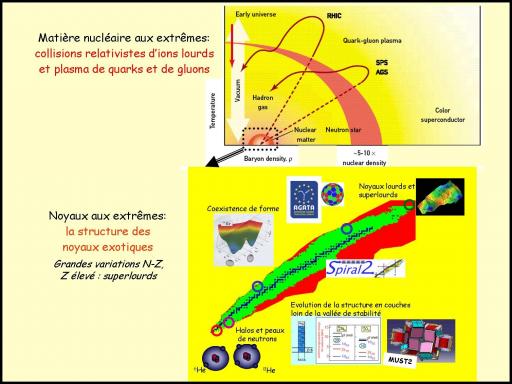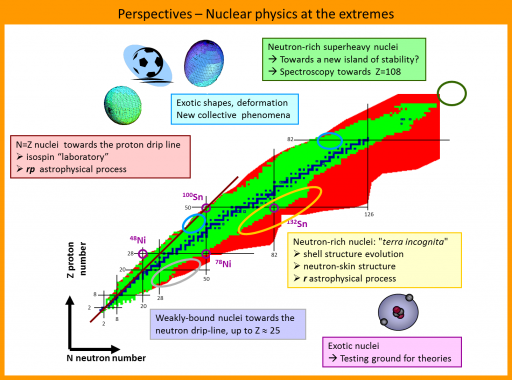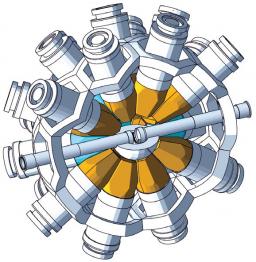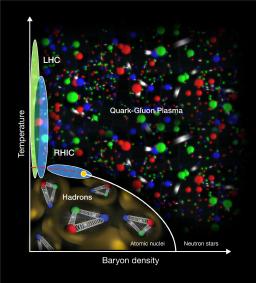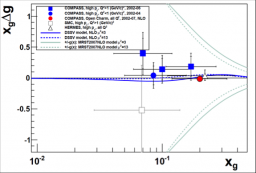Irfu conducts fundamental research, mainly experimental but also theoretical, on nucleons and nuclei, elementary bricks of matter whose cohesion is ensured by strong interaction.
Strong interaction occurs at two successive scales. The first is the assembly of quarks and gluons, whether deconfined in plasma or bound in the nucleon and other hadrons. The second concerns the nucleon assemblies which constitute the nuclei of the different atoms. Irfu's objective is to deepen our knowledge of these systems, as well as to discover extreme states of nuclear matter:
- under extreme conditions of temperature and energy, nucleons and nuclei can lose their identity to give birth to a plasma of quarks and gluons, which one seeks to highlight;
- nuclei under extreme conditions of isospin (N-Z function), spin, Z load, deformation : exotic and superheavy nuclei.
The structural aspect of the atomic nucleus is governed by the interaction between nucleons, protons and neutrons, binded by the strong interaction. This multibody quantum system is often described by a nuclear medium field built on an effective nucleon-nucleon interaction. This interaction became increasingly sophisticated as accurate spectroscopy data accumulated. Until the 1980s, these data mainly came from stable nuclei for which the isospin, related to the difference between the number of protons and neutrons, undergoes slight variations. The isospin dependence of effective nuclear interaction is not well known, which requires in-depth studies.
The study of nuclear reactions aims at describing the mechanisms sustaining the evolution of nuclear matter when it undergoes a modification of its state. This modification can occur after an external excitation (e.g., neutron capture) or internal excitation (e.g., beta decay). This evolution is the consequence of the dynamics of nucleons in interaction with its neighbours and of the reorganization of the nuclear structure.
The complexity of these reactions is inherent to the modeling of the dynamics of an N-body quantum system in strong interaction. At high energy, the nuclear structure effects disappear and the quantum framework can be approximated by classical laws. At lower energy, it is no longer possible to neglect the quantum nature of the nucleons and the modeling is more complex. Nowadays, the so-called ab-initio approaches are still far from being able to describe accurately phenomena in which the role of nuclear structure is very important, as in the case of neutron-nucleus interaction at very low energy where resonances appear in the cross sections or in the case of fission. Measurements are therefore essential and modelling approaches are more phenomenological or effective using diffusion theory and notions of thermodynamics of complex systems.
The interaction between quarks and gluons is described by the Quantum Chromo-Dynamics (QCD) theory. This strong interaction confines the quarks and gluons inside the protons, neutrons and other hadrons. When a hadron is torn apart, its constituting quarks and gluons, instead of being liberated, will recombine with newly created ones to form new hadrons with different properties. However, for very high temperatures QCD predicts the progressive reduction of the strength of the strong force and the subsequent deconfinement of the quarks and gluons. Matter will be in a new state of free quarks and gluons, the quark gluon plasma (QGP).
Approximately a millionth of a second after the Big Bang the temperature of the Universe was about 100.000 times higher than that at the centre of the Sun. The necessary conditions for the presence of a QGP were met. The Universe has since then cooled down resulting in the hadrons that can be seen today. For the last thirty years several experiences have follow, looking to reproduce those conditions in the laboratory, from the SPS to the LHC at CERN near Geneva through RHIC at BNL close to New York. Heavy nuclei, e.g. Lead are accelerated to speeds close to the speed of light, enough to create in the collisions a QGP so small (about the size of a nucleus, 10-15 meters) and that cools down so fast (about 10-23 seconds after the collision) that it cannot be directly seen.
Particle detectors are used to reconstruct the thousands of particles resulting from the hadronization of the QGP as well as those, called hard probes, produced at the very beginning of the collision, even before the QGP creation, which will therefore traverse it. The study of all particles produced by the collisions will allow to study the properties of the QGP.
DPhN is strongly engaged in the study of the partonic structure (in terms of quarks and gluons) of nucleons, protons and neutrons. Nucleons are singular objects as about 90% of their mass originates not from their constituent masses, but rather from the strong interaction they experience. Nucleons are also a benchmark laboratory to study confinement and deconfinement mechanisms which remain an open key point, although QCD is a well established theroy in the standard model. The study of the nucleon structure in terms of quarks and gluons is thus complementary to the investigations of quark-gluon plasma and its associated phase transition.



